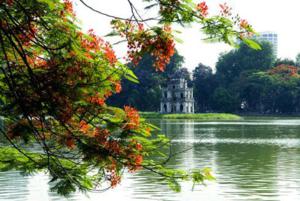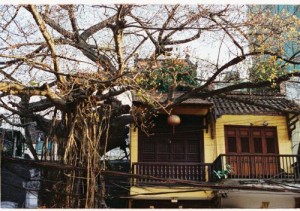Smaller than Saigon, but more beautiful
Hanoi and the surrounding area have plenty to interest visitors. Its central area is compact – most of the main attractions are within walking distance. Tree-lined boulevards, colonial buildings and many lakes make pleasant routes for a pedestrian tour. If you don’t mind becoming an attraction for the Vietnamese, a ‘cyclo’ tour can be a less strenuous way of seeing some of the sites. Visitors that are more adventurous may be attracted by cycling or riding on the back of a motorcycle – however, this is a decision best made after you’ve seen the traffic situation!
It’s also a remarkably safe city. The level of crime is low, and what exists hardly ever involves violence. Apart from commonsense precautions, extra security measures are unnecessary.
The heart of Hanoi
 Hoan Kiem Lake and the Old Quarter in central Hanoi are thronged with people throughout the day. Nearby, in an attractive setting, is the Hanoi Municipal Theatre, better known as the Opera House, a smaller version of its cousin in Paris and now restored to its original grandeur. The adjacent Hanoi Opera hotel is one of the few modern buildings that enhance an architectural classic anywhere in Vietnam.
Hoan Kiem Lake and the Old Quarter in central Hanoi are thronged with people throughout the day. Nearby, in an attractive setting, is the Hanoi Municipal Theatre, better known as the Opera House, a smaller version of its cousin in Paris and now restored to its original grandeur. The adjacent Hanoi Opera hotel is one of the few modern buildings that enhance an architectural classic anywhere in Vietnam.
Haivenu guests will be offered tickets for any interesting performances at the Opera House during their time in the capital. You’ll also be invited to a performance of water puppetry, an art form unique to North Vietnam and an interesting, humorous introduction to its traditional culture.
The Ho Chi Minh complex
The area dedicated to the late President Ho Chi Minh is well worth a visit. Viewing his embalmed body in an imposing mausoleum is a somewhat macabre experience, but the nearby museum and his modest small stilt house provide a valuable insight into the life and times of one of the most successful leaders of the 20th century. Close by is the magnificent Presidential Palace, unfortunately not open to visitors.
Van Mieu
Van Mieu, (the Temple of Literature) dates back to the 11th century and is the oldest university in Vietnam (and one of the oldest in the world). Recently restored, it is a now an attractive and informative monument not far from the city centre. (See more Visit Hanoi’s ancient Temple of Literature: Van Mieu).
Museums
Further out is the Museum of Ethnology – we rate it as the best museum in Vietnam. It gives an in-depth overview of the complex life-styles, traditions and handicrafts of the 54 ethnic groups of Vietnam, well-presented and effectively interpreted. Also of note, but more traditional in their approach, are the History Museum, the Army Museum and the Fine Arts Museum. On a much smaller scale, both physically and financially, the Women’s Museum focuses on the role of women in the community and that of the ‘Long-haired Army’, the many women who fought and died alongside the men of the Viet Minh and the Viet Cong.
The Citadel area
The ancient Hanoi Citadel is currently occupied by the army, but is in the process of restoration prior to making sections accessible to the public during 2004.
Across the road, a large archaeological ‘dig’ currently taking place on the site of what will be the new National Assembly building has unearthed what appear to be the remains of an ancient palace and its ceramics kiln. Ceramic articles were the sole property of royalty, and were thought to have been imported from China during its Song period. The findings have revealed that Vietnam not only made its own ceramic articles, but also developed a unique style during the Ly Dynasty from the 9th to the 11th centuries.

Amenities
Hanoi currently boasts Vietnam’s most modern airport, Noi Bai, opened only a couple of years ago 35 km from the city, and already planning a second terminal. The city has seven five-star hotels and a wide range of hotels at lower standards. There is a large variety of restaurants offering most of the main international cuisines and nearly all of the differing styles of Vietnamese food. They range from top-flight gourmet establishments with prices to match, to street-side ‘cafés’ where a filling meal often costs less than a dollar.
It’s a shopper’s paradise. There are retail outlets ranging from massive indoor markets to humble street stalls, upmarket designer brands, western-style supermarkets and, of course, the commercial centre in the Old Quarter where you can find practically anything from ripped-off DVD’s for less than a dollar to a tastefully designed tombstone with your likeness inscribed into the stone.
There are plenty of banks and currency exchange outlets, and ATM’s dispensing local currency are now commonplace.
Taxis are cheap, metered and usually reliable. “Cyclo” and “Xe Om” are a different matter!
Source: haivenu-vietnam
